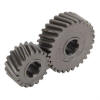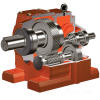| Type of Gears -
Helical Gear |
|
Video |
| A helical gear is a type of
cylindrical gear with teeth that are cut at an angle to its axis,
forming a helix. This angled design allows for smoother, quieter
operation and higher load capacity compared to spur gears because more
than one tooth is engaged at any given time, distributing the load.
However, this also generates axial thrust, which requires additional
thrust bearings to handle. |
| |
| Advantages: |
- Smooth and quiet operation:
- The gradual engagement of
teeth results in less vibration and noise.
- High load capacity: The load
is distributed across multiple teeth, making them suitable for
high-load applications.
- Increased durability: The
load distribution among teeth leads to greater durability.
- High-speed applications:
Their design makes them well-suited for high-speed machinery like
vehicle transmissions, machine tools, and speed reducers.
|
| Disadvantages |
- Axial thrust: The
helical design creates a thrust force that pushes the gear axially
along its shaft, requiring thrust bearings to absorb this force and
increasing bearing wear.
- Higher cost: Helical
gears are more expensive to manufacture than spur gears because of
the complexity of their design and the need for specialized tools.
- Lower efficiency: The
sliding friction caused by the helix angle leads to a slightly lower
efficiency compared to spur gears (around 96%-98%)
|
| How they work |
- Meshing: Helical gears
are typically used in parallel shaft arrangements, but they can also
be crossed. For a parallel setup, the helix angles of two meshing
gears must be the same, but the direction of the helix must be
opposite (one right-hand, one left-hand).
- Engagement: The angled
teeth engage more gradually than straight teeth, starting at one end
of the tooth and progressively extending across the face, which
reduces noise and impact.
- Force transfer: The
load is distributed across multiple teeth simultaneously due to the
helical shape, increasing the gear's torque-carrying capacity.
|
| Materials and
applications |
- Materials: They are
made from various materials, including plastic (like acetal or
nylon) and metals (like aluminum, brass, and stainless steel)
- Applications: They are
widely used in industries such as automotive, manufacturing, and
consumer electronics.
Plastic gears: These are lightweight, non-rusting, and can
operate without lubrication, making them suitable for food
production and medical equipment.
- Metal gears: These
offer greater strength, load-carrying capacity, and heat
resistance.
|
|
|



